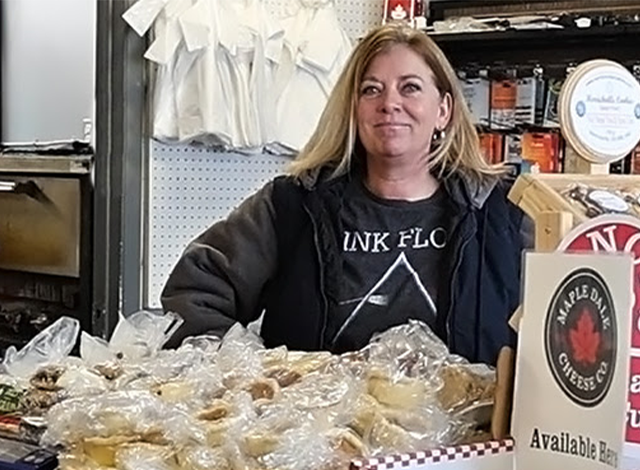Several years ago, I unearthed a strange object in our backyard. It was a disc of pale green glass with the markings “F & G.” My efforts to research this artifact proved unsuccessful until recently, when I spotted an old, pale green bottle at a local collectable store. The quart sized vessel had the markings “F. & G. Conlin/Trade T & B Mark/Smiths Falls.” The round base markings read “F & G.” “The game is afoot,” I muttered to myself as I drove home with my newfound treasure. Ten minutes later, I was glued to my laptop. According to The Record News, I was not the first person to dig up an F. & G. Conlin bottle. Brenda Ferguson had found a similar artifact while digging in her garden years ago. My online soda water sleuthing continued, as I uncovered the origins of this sparkling phenomenon.
In 1772, Joseph Priestley was awarded the Royal Society’s Copley Medal for his invention of what we know as sparkling, carbonated, fizzy, or soda water. In 1783, watchmaker and amateur scientist Johann Schweppe used Priestley’s research to mass produce carbonated mineral water and went on to produce the world’s first soft drink. Just over a century later, Atlanta pharmacist John Stith Pemberton combined the African kola nut with cocaine to create what remains the most popular soft drink on the planet—Coca-Cola. The powerfully addictive stimulant drug was later deleted from the recipe. In 1892, American inventor William Painter received a patent for his design of a crown cork bottle cap. This technological innovation revolutionized the beverage industry.
Priestley, Schweppe, Pemberton, and Painter set the stage for the soda water industry at the turn of the century. This was a time when many sources of drinking water were polluted. Death from typhoid was a very real concern. Many people chose to pay a premium for clean, healthy, sparkling mineral water. Soda water was successfully marketed as a beverage with health benefits including providing energy, help with digestion, and treating nervous ailments. In 1892, Toronto entrepreneurs Thomas Tune and Thomas Beck capitalized on the situation. They founded a soda water and mineral water business with the trademark T&B. The bottling business sold within two years. The new owner was British brewer Robert Edwin Irvine (1864-1927). He manufactured soda water in Toronto until 1895, using three bottle designs featuring the T&B trademark.
In the late 1800s, Toronto newspapers would routinely extol the virtues of living in the prosperous town of Smiths Falls along the Rideau Canal. This likely factored into Irvine’s decision to bring T&B soda water to the thriving railway metropolis of the Ottawa Valley in 1896. Upon his arrival, Irvine began a business as a soda and aerated waters manufacturer, which continued until about 1909. He used the T&B trademark on three different Irvine/Smiths Falls bottle designs.
My internet research continued with help from the 1901 census. It documents Irvine as living in Smiths Falls with his wife Elizabeth Louisa McClure, their three sons, and his 80-year-old father-in-law. The same census lists Robert Irvine as a lodger at the Butler House Hotel in Ottawa. Irvine had expanded his business and was now a manufacturer of mineral water at 359 Wellington Street in the nation’s capital. By 1903, Irvine was also an agent for Sanitaris and had moved to offices at 200 Bay Street, living at the same address. In 1904, his three sons between the ages of twelve and fifteen are listed as clerks, working at Irvine’s plant. Business must have been booming because in 1906, Irvine purchased one of the country’s finest livery and boarding stables in Ottawa. At the time, Irvine was the local agent for several beverages including Russell Lithia, a sparkling beverage made by Ottawa’s Canada Mineral Waters Co. Ltd., and Toronto’s Reinhardt beer. In addition, Irvine sold his own products, which included soda water, ginger ale, and sarsaparilla.
In 1907, the R. E. Irvine company changed its name to R. Irvine Ltd. By 1910, the Irvines had relocated to British Columbia. R. Irvine Ltd. had acquired Cross & Company Soda Water and was operating it in Vancouver. The Morel Bros. purchased the Irvine soda water business in Ottawa, and F. & G. Conlin acquired the soda water bottling rights with the T&B trademark in Smiths Falls. Patrick Francis “Frank” Conlin (1858-1930) and George Thomas Conlin (1860-1943) were the proud new owners of this local industry.
After exhausting all the online resources I could think of, I found myself in the basement of the Smiths Falls Heritage House Museum. Grateful for access to the museum’s collection including the Lanark County Genealogical Society Reference Library, I put on archival gloves, and carefully examined an old telephone directory. Goosebumps materialized when I discovered that in 1918, Frank Conlin was living at 110 Chambers Street with his wife Elizabeth Ann (Leach) Conlin and their only daughter, Francis. My search continued as I pored over a 1919 leather bound Assessment Roll. It contained a list of the assessed values of all the properties in Smiths Falls including the names of the property owners and tenants and their addresses. Frank Conlin is listed as a Soda Water Manufacturer with his business address at 24 Daniel Street at the corner of McGill Street. Frank’s 1930 death certificate indicated he had a history of cardiovascular troubles. He was found dead at work at 24 Daniel Street at the age of 72. George Conlin was married to Elizabeth “Lizzie” Leech and they had eight children together. The 1940 directory lists G. T. Conlin living at 41 Main Street.
The final step of my investigation involved some social media assistance. I posted a photo of my F. & G. Conlin bottle in the hopes that someone might have some information to share. Facebook was very helpful! I had the pleasure of a telephone conversation with Barry Conlin, a descendant of the F. & G. Conlins. His great-grandfather was Joseph William Conlin. Frank and George were his great-granduncles. Two days later the Keyhole House doorbell rang, and Barry was standing in front of me holding two F. & G. Conlin bottles. He explained that there were two sizes, a pint size and a quart size. Several bottles have survived with the markings “F. & G. Conlin/Trade T & B Mark/Smiths Falls.” Two different base markings are known to exist including “F & B” and “C.” Due to impurities in the glass and prolonged exposure to sunlight some of the bottles have developed a pale green, pink, or purple colour. Scientists use the term “solarized glass” to describe this phenomenon. Barry Conlin explained that the oldest bottle in his collection has a wire stopper on it. In the world of antique bottle collecting, it is referred to as a Quart Sized Blob Top Soda Bottle with a Putnam Closure.
My quest to celebrate the F & G Conlin bottle discovered at the Keyhole House is almost complete. I am excited to be sharing the story of Robert Irvine, brothers Frank and George Conlin and their Smiths Falls bottling business, and the Keyhole House. In all likelihood, the bottle in our backyard brought sparkling refreshment to Augusta and Reginald Burroughs who lived at this address from 1907 to 1923 or to Alice McNeill who lived here from 1923 until 1933.
Ted & Marion Outerbridge are currently restoring the Keyhole House, a Smiths Falls heritage home built in 1893. They are also being swept away by local history & mystery. You can follow them on Instagram, Facebook, and TikTok @thekeyholehouse or email ted@tedouterbridge.com.




















